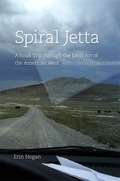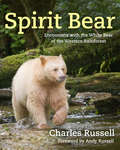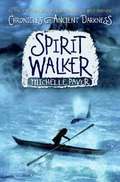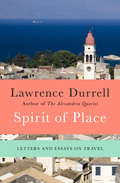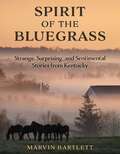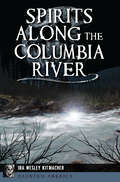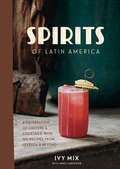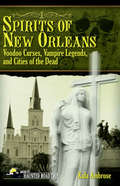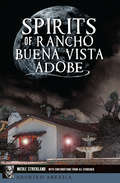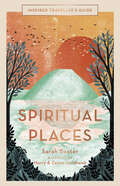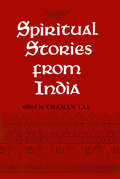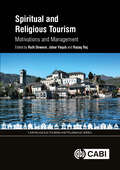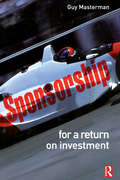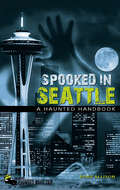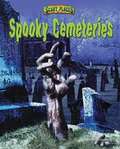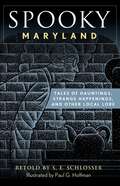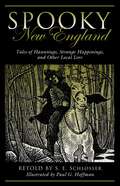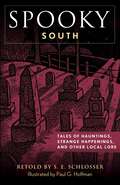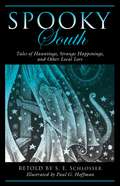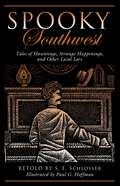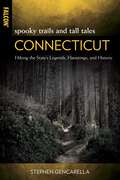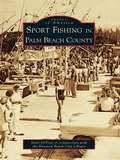- Table View
- List View
Spiral Jetta Summer: Swimming in the Great Salt Lake
by Erin HoganErin Hogan hit the road in her Volkswagen Jetta and headed west from Chicago in search of the monuments of American land art: a salty coil of rocks, four hundred stainless steel poles, a gash in a mesa, four concrete tubes, and military sheds filled with cubes. Her completed journey took her through the states of Utah, Nevada, New Mexico, Arizona, and Texas. It also took her through the states of anxiety, drunkenness, disorientation, and heat exhaustion. Spiral Jetta Summer is a chronicle of this adventure, and it reveals Hogan's unpretentious and boisterous narrative flair on the roads of middle-of-nowhere Utah in pursuit of Robert Smithson's classic work Spiral Jetty. Along the way, Hogan writes about venturing outside of her urban comfort zone; who she encounters; and most importantly, how she found most of what she was looking for and then some.
Spiral Jetta: A Road Trip through the Land Art of the American West (Culture Trails Ser.)
by Erin HoganErin Hogan hit the road in her Volkswagen Jetta and headed west from Chicago in search of the monuments of American land art: a salty coil of rocks, four hundred stainless steel poles, a gash in a mesa, four concrete tubes, and military sheds filled with cubes. Her journey took her through the states of Utah, Nevada, New Mexico, Arizona, and Texas. It also took her through the states of anxiety, drunkenness, disorientation, and heat exhaustion. Spiral Jetta is a chronicle of this journey.A lapsed art historian and devoted urbanite, Hogan initially sought firsthand experience of the monumental earthworks of the 1970s and the 1980s—Robert Smithson’s Spiral Jetty, Nancy Holt’s Sun Tunnels, Walter De Maria’s Lightning Field, James Turrell’s Roden Crater, Michael Heizer’s Double Negative, and the contemporary art mecca of Marfa, Texas. Armed with spotty directions, no compass, and less-than-desert-appropriate clothing, she found most of what she was looking for and then some.“I was never quite sure what Hogan was looking for when she set out . . . or indeed whether she found it. But I loved the ride. In Spiral Jetta, an unashamedly honest, slyly uproarious, ever-probing book, art doesn’t magically have the power to change lives, but it can, perhaps no less powerfully, change ways of seeing.”—Tom Vanderbilt, New YorkTimes Book Review“The reader emerges enlightened and even delighted. . . . Casually scrutinizing the artistic works . . . while gamely playing up her fish-out-of-water status, Hogan delivers an ingeniously engaging travelogue-cum-art history.”—Atlantic“Smart and unexpectedly hilarious.”—Kevin Nance, ChicagoSun-Times“One of the funniest and most entertaining road trips to be published in quite some time.”—June Sawyers, ChicagoTribune“Hogan ruminates on how the work affects our sense of time, space, size, and scale. She is at her best when she reexamines the precepts of modernism in the changing light of New Mexico, and shows how the human body is meant to be a participant in these grand constructions.”—New Yorker
Spiral Jetty: A Road Trip Through the Land Art of the American West
by Erin HoganIn the late 1960s the artist Robert Smithson went looking for red. Scouting possible sites for what would eventually be his signature work, the Spiral Jetty, he wanted, he wrote, quoting G. K. Chesterton, "that most joyful and dreadful thing in the physical universe... the fiercest note... the highest light."
Spirit Bear: Encounters with the White Bear of the Western Rainforest
by Charles RussellA classic work of nature and wildlife, Spirit Bear is the captivating story of wilderness guide and naturalist Charles Russell’s quest to understand the rare spirit bear of British Columbia’s Princess Royal Island — now updated and reissued with a new design and an afterword by the author.From early experiences observing black bears in the Rocky Mountains with his father, the well-known writer and broadcaster Andy Russell, to nerve-racking encounters with grizzlies in British Columbia’s Khutzeymateen Valley, Charles Russell has spent a lifetime studying bears in their natural habitat. In 1991, Russell visited Princess Royal Island, an uninhabited island off the coast of British Columbia. There, amidst the rivers and trees of the western rainforest, he encountered the elusive spirit bear.Known to scientists as the Kermode bear and to the public as the white, ghost, or spirit bear, these extraordinary animals have never been exposed to civilization. In Spirit Bear, Russell recounts his experiences on Princess Royal Island — trekking over rocks and through streams; waiting hours for the evasive ghost bear to appear; and finally coming face-to-face with a spirit bear only inches from his nose. Illustrated with more than 100 stunning colour photographs, Spirit Bear provides beautiful and astonishing insight into the habits and nature of the Kermode bear, and is part of an ongoing effort by conservationists to save Princess Royal Island as a sanctuary for these remarkable animals.
Spirit Walker (Chronicles of Ancient Darkness #2)
by Michelle PaverFrom the Publisher As the Moon of No Dark waxes large, the clans fall prey to a horrifying sickness. Fear stalks the Forest. No one knows the cause-and only Torak can find the cure. His quest takes him across the sea to the mysterious islands of the Seal Clan. Here, Torak battles an unseen menace and uncovers a betrayal that will change his life-forever.
Spirit of Place: Letters and Essays on Travel
by Lawrence DurrellThe definitive collection of travel writings by one of the twentieth century&’s best-loved journeyersFrom the moment of his birth, Lawrence Durrell was far from home. A British child in India, he was sent to England to receive an education, and by his early twenties had already tired of his native land. With family in tow, he departed for Greece, and spent the rest of his life wandering the world. He traveled not to sightsee but to live, and made homes in Egypt, France, Yugoslavia, and Argentina. Each time he landed, he rooted himself deep into the native soil, taking in not just the sights and sounds of his new land, but the essential character of the country. In these letters and essays, Durrell exhibits the power of poetic observation that made his travel writing so extraordinary to post–World War II readers. In these pages he reminds us not just of each country&’s hidden charms, but of the unique characteristics that persist through the generations.
Spirit of the Bluegrass: Strange, Surprising, and Sentimental Stories from Kentucky
by Marvin BartlettEmmy-Winning Journalist Marvin Bartlett's 35-year journey through Kentucky's unique stories.For thirty-five years, Emmy award-winning television journalist Marvin Bartlett has traveled the state, collecting stories that define The Spirit of the Bluegrass. If a story is odd, inspirational, educational, or nearly unbelievable, it is a perfect fit for the feature segments prepared for broadcast in Kentucky from border to border. Travel with Marvin to soak up that spirit found in people, places and things that are unique to the Bluegrass State.
Spirits Along the Columbia River (Haunted America)
by Ira Wesley KitmacherThe breathtaking scenery of the Pacific Northwest hides a myriad of dark secrets.From sightings of the Columbia River Sea Serpent, nicknamed "Colossal Claude," to tales of Bigfoot encounters dating back to 1865, strange creatures lurk both on land and at sea. Shipwrecks, drownings, shanghaiing, and nautical superstitions abound. The restless settler spirits of those who lived and died on the Oregon Trail are said to linger alongside apparitions of adventurers and soldiers, while others, including the 1920's-era ghost of a woman in white and a man in top hat haunt places like the Columbia Gorge Hotel.Join author Ira Wesley Kitmacher as he takes you on a journey through one of the most haunted regions in America.
Spirits of Latin America: A Celebration of Culture & Cocktails, with 100 Recipes from Leyenda & Beyond
by Ivy MixA James Beard Award-nominated bartender explores the history and culture of Latin American spirits in this stunningly photographed travelogue—with 100+ irresistible cocktails featuring tequila, rum, pisco, and more. &“Ivy&’s unique combination of taste, talent, and tenacity make her the ideal &‘spirit&’ guide.&”—Steven Soderbergh, filmmaker, professional drinker, and owner of Singani 63Through its in-depth look at drinking culture throughout Latin America, this gorgeous book offers a rich cultural and historical context for understanding Latin spirits. Ivy Mix has dedicated years to traveling south, getting to know Latin culture, in part through what the locals drink. What she details in this book is the discovery that Latin spirits echo the Latin palate, which echoes Latin life, emphasizing spiciness, vivaciousness, strength, and variation. After digging into tequila and Mexico's other traditional spirits, Ivy Mix follows the sugar trail through the Caribbean and beyond, winding up in Chile, Peru, and Bolivia, where grape-based spirits like pisco and singani have been made for generations. With more than 100 recipes that have garnered acclaim at her Brooklyn bar, Leyenda, including fun spins on traditional cocktails such as the Pisco Sour, Margarita, and Mojito, plus drinks inspired by Ivy's travels, like the Tia Mia (which combines mezcal, rum, and orange curacao, with a splash of lime and almond orgeat) or the Sonambula (which features jalapeño-infused tequila, lemon juice, chamomile syrup, and a dash of Peychaud's bitters), along with mouthwatering photos and gorgeous travel images, this is the ultimate book on Latin American spirits.
Spirits of New Orleans
by Kala AmbroseThe city of New Orleans is formed into the shape of a crescent, which is believed by many people to form a sacred chalice which holds and stores energy making it one of the most unique areas in the world in which to perform magic and to see it magnify due to the energy in the land and from the flowing waters of the Mississippi and Gulf of Mexico.Since childhood, Kala Ambrose has seen and felt ghosts and restless spirits. During this journey as your travel guide, Kala explores the history of the city and those who decided to make it their eternal home.Explore New Orleans with Kala Ambrose and prepare to embark on a unique and enticing journey into the haunted history and magical ceremonies of New Orleans. Prepare to be introduced to supernatural rituals and practices in order to fully understand and embrace the cultural significance of the variety of beliefs, superstitions, legends and lore.
Spirits of Rancho Buena Vista Adobe (Haunted America)
by Nicole Strickland Ali SchreiberThe Rancho Buena Vista Adobe stands as a testament to California's diverse past and offers a glimpse into the supernatural. Learn the identity of the apparition known as the "Lady in White," which startles unsuspecting guests by serenely floating across the rancho's courtyard, and the tale of a skeleton rumored to be sealed up somewhere within the rancho's walls. Discover the story of Cave Johnson Couts and family, who continue to chat with visitors in spirit form. And explore the rooms where whispering voices are often heard, even when they're empty. Join author Nicole Strickland as she uncovers spine-tingling haunts and restless souls.
Spiritual Places (Inspired Traveller's Guides #1)
by Sarah BaxterFrom the natural splendour of Devils Tower in Wyoming, to the medieval pilgrimage of Camino de Santiago that stretches to Spain, Inspired Traveller's Guides: Spiritual Places explores locations that will be a balm to the mind and a tonic to the soul. Travel journalist Sarah Baxter has carefully curated a selection of the 25 most spiritual destinations from around the world – places that hold the promise of rare and profound experiences, whether areas of natural beauty imbued with spiritual significance or sites constructed for worship. From breathtaking scenery to religious capitals, sacred valleys to places of natural beauty, here the full spiritual story and unique tranquillity of each place is revealed with beautiful hand-drawn illustrations and evocative tales of previous visitors that will both delight and inspire.Featured locations: Crater Lake, Oregon, USA; Mauna Kea, Hawaii, USA; Devils Tower, Wyoming, USA; Haida Gwai, Canada; Teotihuacan, Mexico; Lake Titicaca, Bolivia and Peru; Easter Island, Chile; St Catherine's Monastery, Egypt; Kyoto, Japan; Shwedagon Pagoda, Myanmar; Adam's Peak, Sri Lanka; Varanasi and the Ganges, India; Mount Kailash, China; Cape Reinga, New Zealand; Uluru, Australia; Saut d'Eau waterfall, Haiti; Camino de Santiago, Spain; Mezquita de Cordoba, Spain; Isle of Iona, Scotland; Avebury, England; Mont St-Michel, France; Lourdes, France; Luther Trail and Wittenburg Cathedral, Germany; Mount Olympus, Greece; Temple Mount and Jerusalem, Israel. Perfect for those who want to get away from it all, this book takes you closer to these sacred locations than ever before. Each book in the Inspired Traveller's Guides series offers readers a fascinating, informative and charmingly illustrated guide to must-visit destinations round the globe. Also from this series, explore intriguing: Artistic Places (March 2021), Literary Places, Hidden Places and Mystical Places.
Spiritual Stories from India
by Chaman Lal"India is the home of fables," says Mr. Lal in his preface to the book. "When God made the world, He gave many virtues to different nations. To India He gave wisdom as a special gift....The Stories presented in this book are full of wisdom. They illustrate what miracles can be wrought by faith in God. They tell us what we can learn from nature. What tolerance and love can bring to humanity....
Spiritual and Religious Tourism: Motivations and Management (Cabi Religious Tourism And Pilgrimage Ser.)
by Jane Legget Jean Carlos Santos Dr Shin Yasuda Dane Munro Onur Akbulut Vincente De Silva Yakin Ekin Özlem Güzel Suzanne Histen Jaffer Idris Tadeja Jere Jakulin Professor Maximiliano Korstanje Anne Liden Luana Moreira Marques Jahanzeeb Qurashi Ilker Sahin Ayça Sariyildiz Richard Keith Wright Seda YetímogluThis book reviews tourist motivations for making religious or spiritual journeys, and the management aspects related to them. It explores sacred journeys across both traditional religions such as Christianity and Islam, and newer forms of pilgrimage, faith systems and quasi-religious activities such as sport, music and food. Demonstrating to the reader the intrinsic elements and events that play a crucial role within the destination management process, it provides a timely re-assessment of the increasing interconnections between religion and spirituality as a motivation for travel. The book: - Includes applications, models and illustrations of religious tourism and pilgrimage management for converting theory into good practice; - Addresses theories of motivation and why travel to religious destinations has increased; - Explores key learning points from a selection of international case study perspectives. Providing researchers and students of tourism, religious studies, anthropology and related subjects with an important review of the topic, this book aims to bridge the ever-widening gap between specialists within the religious, tourism, management and education sectors.
Sponsorship: For a Return on Investment
by Guy MastermanSponsorship is both a critical communications tool for sponsors as well as a fundamental revenue stream for rights owners. Market leaders use sponsorship widely and arguably more successfully than any other communications tool to achieve competitive advantage whilst events of all sizes depend on sponsorship just to exist. As the importance of sponsorship has increased the demands of it have risen too. Now sponsors seek measurable return on their investment. Sponsorship: For a Return on Investment provides a unique insight on the use of sponsorship for a return on investment and will appeal to practitioners and undergraduate and postgraduate students alike. It builds a conceptual framework for the development, planning, implementation and evaluation of strategies for sport, arts, music and community sponsorship, and from two perspectives: For rights owners, the importance of effectively acquiring and then developing a bespoke approach for the recruitment of sponsors for effective sponsorship programmes. For sponsors, a better understanding of how sponsorship can be used for successful integrated marketing communications. A broad selection of examples and case studies from around the world are provided in order to demonstrate the importance of sponsorship on an international basis. This book is vital resource for both students and practioners.
Spooked in Seattle
by Ross AllisonSeattle may not be as old as some would expect from a haunted city. But it has a large number of haunted sites and stories. Spooked in Seattle will lead readers on a journey through Seattle's neighborhoods and reveal the city's public locations, history, and tales of strange encounters. For those who love to venture off into corners in search of ghosts and the unknown, this book will set readers forth in the right direction.Spooked in Seattle features more than 150 haunted locations, historic and contemporary photos, top ten questions about ghosts, Seattle's top ten most haunted places, location maps and addresses, Seattle history and haunted facts, Seattle cemeteries and tombstone symbols, and more.Spooked in Seattle presents many locations throughout the city that are believed to be haunted, claim to have ghosts, or have undergone investigation. All of these stories are broken down into sections based on the city's neighborhoods with corresponding addresses to make finding them easier for the ghost enthusiasts. Maps and photos help bring to life the locations, making the Seattle ghosthunting experience easy and enjoyable.
Spooky Cemeteries (Scary Places)
by Dinah WilliamsIn the late 1800s, her family was hit by tuberculosis. First, her mother and sister died. Then Mercy herself became sick and died. In desperation to save his tubercular son, her father who had become convinced that Mercy was a vampire rising from the grave each night to suck the life blood from her sibling dug up her body, cut out her heart and burned it, and served the ashes to her brother.
Spooky Maryland: Tales of Hauntings, Strange Happenings, and Other Local Lore (Spooky)
by S. E. SchlosserPull up a chair or gather round the campfire and get ready for thirty-four creepy tales of ghostly hauntings, eerie happenings, and other strange occurrences in Maryland. Set in the Old Line State&’s city streets, rural communities, wooded mountains, and vast shoreline, the stories in this entertaining and compelling collection will have readers looking over their shoulders again and again. Maryland&’s folklore is kept alive in these expert retellings by master storyteller S. E. Schlosser and in artist Paul Hoffman&’s evocative illustrations. Set way back near the cold, calm waters of Crisfield, in the quiet rural farmlands of Venton, and in the dark, heavily wooded swamplands of Cambridge, the stories in this entertaining and compelling collection will have you looking over your shoulder again and again. Readers will feel an icy wind on the back of their necks on a warm evening. Whether read around the campfire on a dark and stormy night or from the backseat of the family van on the way to grandma&’s, this is a collection to treasure.
Spooky New England: Tales Of Hauntings, Strange Happenings, And Other Local Lore (Spooky)
by S. E. SchlosserA collection of folktales highlighting famous and not-so-famous New England ghosts, mysterious happenings, powers of darkness, and wonders of the invisible world. Pull up a chair or gather round the campfire and get ready for 35 creepy tails of ghostly hauntings, eerie happenings, and other strange occurrences in Maine, New Hampshire, Vermont, Connecticut, Rhode Island, and Massachusetts. Set in New England's historic towns, charming old islands, and sparsely populated backwoods, the stories in this entertaining and compelling collection will have you looking over your shoulder again and again.Yankee folklore is kept alive in these expert retellings by master storyteller S.E. Schlosser, and in artist Paul Hoffman's evocative illustrations. You'll meet seaweed-covered phantom sailors and a ghostly black dog, hear otherworldly voices and things that go bump in the night, and feel an icy wind on the back of your neck on a warm summer evening. Whether read around the campfire on a dark and stormy night or from the backseat of the family van on the way to grandma&’s, this is a collection to treasure.
Spooky South: Tales of Hauntings, Strange Happenings, and Other Local Lore (Spooky)
by S. E. SchlosserHere we have a collection of unnerving tales of events that happened--and still do happen--in the collective back yard of the Deep South states. Accompanied by evocative illustrations, these compelling retellings of 43 popular folktales feature supernatural occurrences and ghosts of all sorts, from fiddling ghosts to the story of the Jack o'Lantern. Whether read around the fire on a dark and stormy night or in the backseat of the family van on the way to Grandma's, each expertly told tale is guaranteed to make readers look at the South--and over their shoulders--again and again.
Spooky South: Tales of Hauntings, Strange Happenings, and Other Local Lore (Spooky)
by S. E. SchlosserHere we have a collection of unnerving tales of events that happened--and still do happen--in the collective back yard of the Deep South states. Accompanied by evocative illustrations, these compelling retellings of 40 popular folktales feature supernatural occurrences and ghosts of all sorts, from fiddling ghosts to the story of the Jack o'Lantern. Whether read around the fire on a dark and stormy night or in the backseat of the family van on the way to Grandma's, each expertly told tale is guaranteed to make readers look at the South--and over their shoulders--again and again.
Spooky Southwest: Tales Of Hauntings, Strange Happenings, And Other Local Lore (Spooky)
by S. E. SchlosserA collection of folktales highlighting famous and not-so-famous Southwestern ghosts, mysterious happenings, powers of darkness, and wonders of the invisible world. Here we have a collection of unnerving tales of events that happened—and still do happen—in the collective back yard of the Southwestern states. Accompanied by evocative illustrations, these compelling retellings of popular folktales feature supernatural occurrences and ghosts of all sorts, from cattle rustlers to runaway trains. Pull up a chair or gather round the campfire and get ready for 35 creepy tails of ghostly hauntings, eerie happenings, and other strange occurrences in Nevada, Utah, Arizona, Colorado and New Mexico, and Texas. Set in the American Southwest's historic towns and sparsely populated expanses, the stories in this entertaining and compelling collection will have you looking over your shoulder again and again.
Spooky Trails and Tall Tales Connecticut: Hiking the State's Legends, Hauntings, and History
by Stephen GencarellaConnecticut—a New England state with a proud history and vibrant culture. But there is more to this place than white church steeples and town greens. In the forests and meadows surrounding these quaint, colonial towns lurk spine-chilling ghosts protecting Captain Kidd&’s treasure, the abode of the Devil himself, and shadowy creatures such as the Glawackus, all awaiting the next hiker to stumble down the trail.For years, the stories of these mysterious beings and places existed only in whispers and campfire tales, but now for the first time these legends have been collected and retold in one volume: Spooky Trails and Tall Tales Connecticut. Alongside each of these captivating tales is the necessary route and trailhead information brave readers will need to go beyond their town lines and test their nerve.Proud to support Friends of Connecticut State Parks with a portion of the royalties.
Sport & Tourism: A Reader
by Mike WeedThis Reader provides comprehensive coverage of the scholarly literature in sports tourism. Divided into four parts, each prefaced by a substantial introduction from the editor, it presents the key themes, state of the art research and new conceptual thinking in sports tourism studies. Topics covered include: understanding the sports tourist impacts of sports tourism policy and management considerations for sports tourism approaches to research in sports tourism Articles cover a broad range of the new research that has a bearing on sports tourism and include diverse areas such as the economic analysis of sports events, sub-cultures in sports tourism, adventure tourism and tourism policy.
Sport Fishing in Palm Beach County (Images of America)
by Boynton Beach City Library Janet DevriesSettled along 47 miles of beautiful Atlantic coastline, Palm Beach County has long been a mecca for sport fishing enthusiasts. Graced with a mild climate and bounded with waters nourished by the warm Gulf Stream current, Palm Beach's coastal waters host a rich reserve of marine life. Featured in this captivating retrospective is a history of the sport fishing industry and tales of legendary captains, devoted weekend anglers, and wealthy sportsmen. Bringing to life the sailfish tournaments, fish fries, beauty pageants, and parades of a bygone era, this work is a tribute to the hardworking men and women who built this seaside settlement into a haven for sport fishermen. Follow the evolution of fine fishing boats and learn about the advancements in marine conservation while enjoying the natural beauty of this tropical oasis. Showcased within the book are over 200 vintage images collected from the local library's historical archive, as well as rare photographs from over 30 local sources, including the West Palm Beach Fishing Club.

